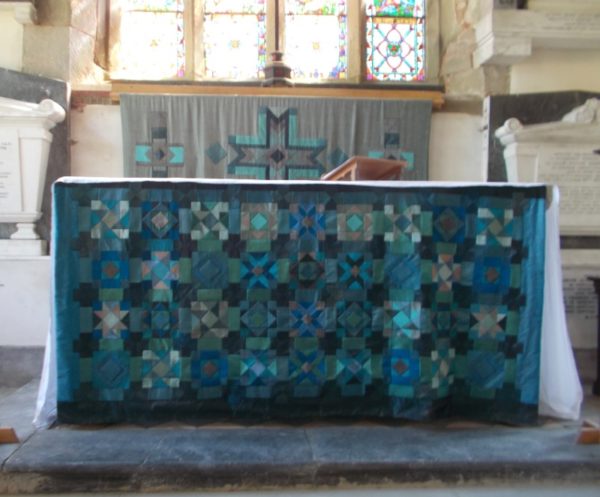
All Saints Church Newland Gloucestershire: altar frontal designed by Sylvia Green under Beryl Dean and worked by their team of former students.
I’m conscious of describing All Saints Newland as being in Gloucestershire while elsewhere I refer to its location as The Forest of Dean and it struck me how confusing this could be if you don’t know the area. The Forest of Dean is the little triangle of Gloucestershire contained within the course of the rivers Severn and Wye and extending north from their confluence in the south to a line running East-West from Gloucester to Ross-on-Wye. The land between the rivers rises to a high plateau cut by ridges of limestone and sandstone which create deep forested valleys and sudden breathtaking views. Mined for ore and with plentiful wood for charcoal it has been a place of iron working since prehistoric times. (Also some tin, from which heritage came the bequest which helped fund the furnishings discussed here.) Under the Saxons it became a royal hunting ground and many ancient rights and privileges come from its unique heritage as a Royal Hunting Forest. The forest itself, originally oak and beech, has played an important role in English history – from providing the timber for Sir Francis Drake’s fleet which battled with the Spanish Armada to doing the same for Admiral Nelson’s in the war against Napoleon. A friend who has recently restored an Arts and Crafts house just over the border in Monmouthshire knows the man who built the house in the early C20th found stunning oak timbers of 40′ for his garden pergola in the local timber yard, which I seem to remember didn’t happen when she needed to replace some of the same size 100 years later. Today the forest is still a working forest, producing sustainable timber for the UK market.
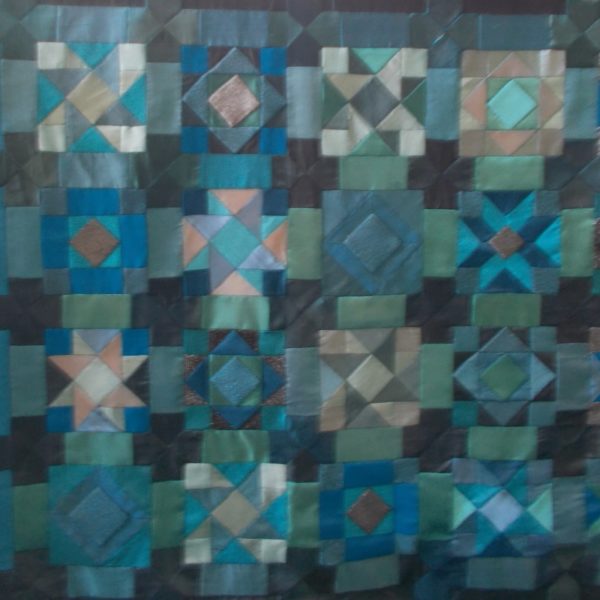
All Saints Church Newland Gloucestershire: detail of altar frontal
patchwork designed by Sylvia Green under Beryl Dean and worked by their team of former students.
The people of the Forest have always regarded themselves as a race apart and even today the rights of the ‘free-miners’ are jealously guarded – there are thought to be about 150 of them today although only a handful of tiny, tiny collieries are still operating. Free sheep grazing rights over the Forest have also continued and drivers on the main roads have to be careful not only of rambling sheep and sprightly deer but also increasingly of thundering wild boar. Only about 15 years ago when we lived in Monmouth a friend’s Volvo had a contretemps with a huge boar which ran out into the main road in front of the car. The boar died, the car was a write off, fortunately, the driver was shaken but otherwise untouched.
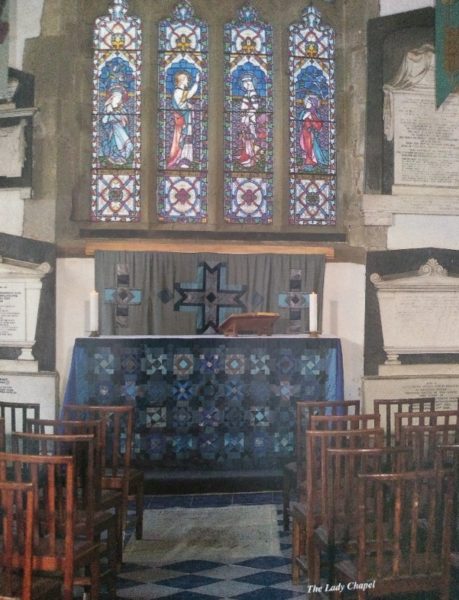
All Saints Church Newland Gloucestershire: Lady Chapel altar frontal designed by Sylvia Green under Beryl Dean and worked by their team of former students.
The church of All Saints, Newland was built in a clearing in the Forest, ‘new land’, in the early C13th probably by the monks of Tintern in an attempt to civilise the somewhat wild and unruly area. Administratively, throughout history, the Forest has sometimes been included in England and sometimes in Wales. Even in terms of church affairs the situation is confusing. The area wasn’t parochialized at all until the late C19th and one of David’s task as vicar was to regularise parish boundaries as pockets of Newland parish remained all over the Forest, when vicars of the church ‘planted’ chapels-of-ease in tiny settlements all over the place. (A chapel-of-ease is a church building other than the parish church, built for the attendance of those who cannot reach the parish church conveniently.) It was into this unique setting – not too strong a description I think – that David and his first wife Joy came and straight away they found things far from easy. Tales abounded about predecessor vicars’ difficulties and wrongdoings which David found to be not entirely fictional but there was also an element of the outsider cleric not being welcomed by insular locals. Last night I went through the Beryl Dean file, read bits out to David and asked for clarification here and there. In the process, I struck some deep well of memories that he would have rather not remembered and which set him off on a night of unpleasant dreams.
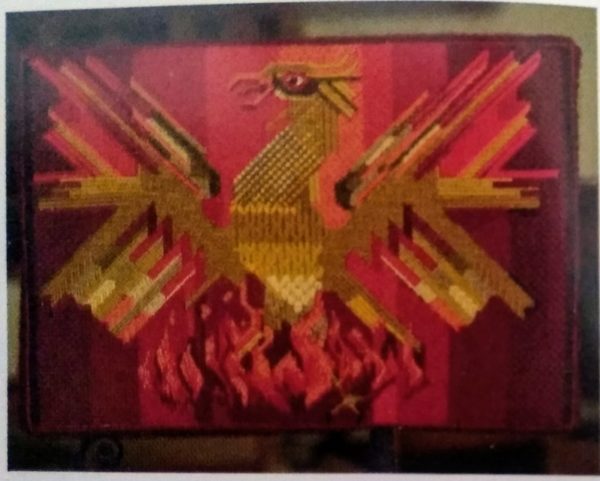
All Saints Church Newland Gloucestershire: Phoenix kneeler designed by Sylvia Green under Beryl Dean and worked by their team of former students.
Unfortunately the furnishings for the Lady Chapel were one of those triggers that so distressed him. Joy had written to ask Beryl Dean if it were possible that they could “interest you in such a venture”, primarily meaning vestments. As mentioned in my last post Beryl didn’t at first say yes but then changed her mind. On visiting, Beryl had found herself ambushed by an overwhelming connection with the building – to the point of falling in love with it, and went away with her head already at work on designs. Within a surprisingly short time she and her team were well on their way with work on various furnishings – and this was before any formal commission had been made. By an unfortunate coincidence a member of her team met a member of the PCC (Parochial Church Council) while on holiday in Spain and there she had talked about the furnishings as being commissioned in that loose way one can do when you’re involved in, but not privy to, full details of a job of work. In his turn the PCC member made assumptions about things commissioned without the knowledge of the PCC and got very upset. Misunderstanding compounded misunderstanding. Accusations of a very unpleasant nature flew about, unkind letters were sent. David was upset; Beryl expressed her distress but gathered herself together and set to thinking how to work through this situation in the most Christian way possible (though she declared herself not to be religious). Joy blamed herself but felt all would come well in the end. Thank Goodness – and thank God – things did come right and the Lady Chapel furnishings were able to find a home in the church for which they had been created and where they look wonderful.
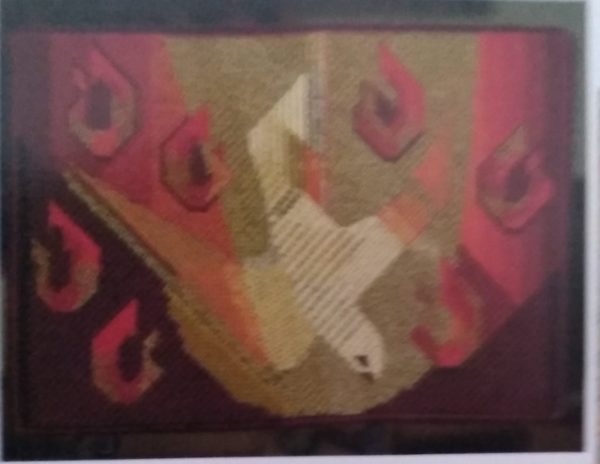
All Saints Church Newland Gloucestershire: dove kneeler designed by Sylvia Green under Beryl Dean and worked by their team of former students.
Now to the furnishings themselves, patchwork altar frontal, appliquéd dossal behind the altar and two kneelers. These were designed by Beryl’s close colleague, Sylvia Green and undertaken as a project by their former students. Their colours echo the C19th glass in the window behind the altar and the predominance of shades of blue is also suitable for a chapel decorated to the Virgin. The two red kneelers too pick up colours in the window glass, though this time the reds and golds, and the stylised birds with their angular forms work well with the patchwork. Now, coming up for 50 years old when we last saw them again a few years ago the furnishings looked in very good condition.
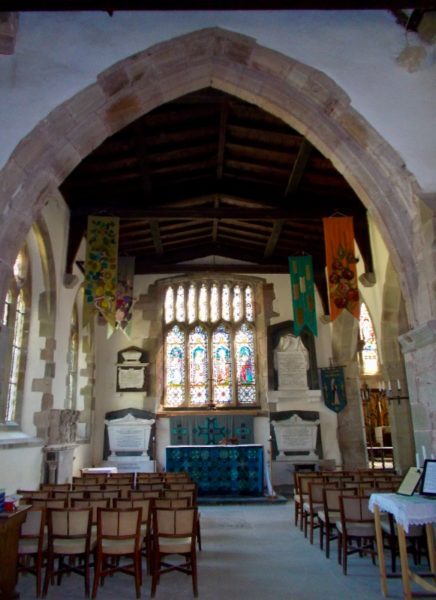
All Saints Church Newland Gloucestershire: Lady chapel furnishings designed by Sylvia Green under Beryl Dean and worked by their team of former students.
Last week we spent a long day in the National Gallery as David was meeting up with a senior curator at the gallery to hand over some more of his research papers. Having from 1pm until 6pm when the gallery closes, we were able to visit many more of the galleries than we would normally be able to do (with several breaks for coffee) and were impressed at the way the pictures were hung and grouped together. (Is this hanging recent or have I just not been very observant?) One gallery, hung with just a few full length portraits from different periods, was stunning and made the people painted feel more immediately human and not just paintings on a wall – I don’t know why but the feeling was visceral and quite jolting. Other galleries seemed similarly to have been well thought out and we even wondered whether in one paintings had been selected to hang together on the basis of wonderful clouds (with a jolly good landscape attached). Vistas enabled portrait to talk to portrait – turning from Rembrandt’s Portrait of Frederick Rihel on Horseback of 1663 it was amusing to find him in the sights of Anthony van Dyck’s Equestrian Charles I of 30 year’s earlier (1637-8). This sort of dialogue evoked by careful hanging of pictures encourages the viewer to check details like the dates which then helps you to remember that the two painters were painting at the same time. Surprisingly, van Dyck’s life only just extended into his 40s (1599-1641), whereas Rembrandt died in his 60s (1606-1669). So no self portraits of the ageing of van Dyck then, although with today’s perspective it’s difficult for some of us to view Rembrandt as old at 63! A fabulous afternoon that has given me ideas for the next visit with the grandchildren in tow!

4 Comments
I’m sorry some of the memories were not good, but I’m not entirely surprised. There was a similarly distressing period in the church my grandfather attended. People get very twitchy and emotional about things relating to their Church, and they don’t necessarily show themselves at their best. And it’s the poor parish priest who gets caught in the middle…
But really good to hear of the visit to the National Gallery – it sounds like a real treat!
Well as David says, you do have to work with the clay you’re given… Like a policeman’s, a parish priest’s lot is not always a happy one.
it is, however, always nice to have your empathy, so thanks for what you say.
Thank you for the history of the beautiful textiles in ‘the cathedral of the Forest’. We are recent newcomers to Monmouth and I can confirm that the altar front is in place and looks wonderful. I didn’t notice the kneelers. I must look harder next time I visit!
Brigid, how kind of you to let me know the altar frontal is still in place and looking good. Thank you.
We loved living in Monmouth soI hope you enjoy it too.